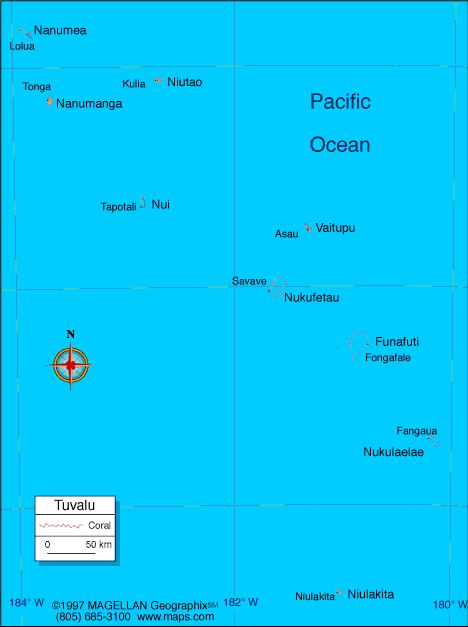TUVALU

Geography: Tuvalu consists of nine small islands scattered over 500,000 sq mi of the western Pacific, just south of the equator. The islands include Niulakita, Nukulaelae, Funafuti, Nukufetau, Vaitupu, Nui, Niutao, Nanumaga (Nanumanga), and Nanumea.
Government: Constitutional monarchy with a parliamentary democracy.
History: Formerly the Ellice Islands, Tuvalu's first Polynesian settlers were probably Samoans or Tongans. The Ellice Islands became a British protectorate in 1892 and were annexed by Britain in 1915–1916 as part of the Gilbert and Ellice Islands Colony. The Ellice Islands were separated from the Gilberts in 1975, given home rule, and renamed Tuvalu. Full independence was granted on Sept. 30, 1978, but Tuvalu remained part of the Commonwealth. In 1979, the U.S. gave Tuvalu four islands that had been U.S. territory.
In 1997, the government adopted a strong stance on the need to control emissions of greenhouse gases in order to ensure the survival of low-lying island nations, which are threatened by rising sea levels—Tuvalu's highest point is just 16 ft above sea level. In 2000, Tuvalu became a member of the United Nations. Tuvalu reportedly makes millions of dollars each year by leasing its highly marketable .tv Internet domain.

Map of Tuvalu
Sovereign: Queen Elizabeth II
(1952)
Governor-General: Iakoba Italeli
(2010)
Prime Minister: Enele Sopoaga
(2013)
Total area: 10 sq mi (26 sq km)
Population (2014 est.): 10,782 (growth
rate: 0.8%); birth rate: 23.74/1000; infant mortality rate:
31.69/1000; life expectancy: 65.81; density per sq mi: 1,142
Capital and largest city (2011 est.):
Funafuti, 5,000
Monetary unit: Australian dollar
Languages:
Tuvaluan, English, Samoan, Kiribati (on the
island of Nui)
Ethnicity/race:
Polynesian 96%, Micronesian 4%
Religions:
Church of Tuvalu (Congregationalist) 97%,
Seventh-Day Adventist 1.4%, Baha'i 1%, other 0.6%
Literacy rate: n.a.
Economic summary: GDP/PPP (2013
est.): $40 million; per capita $3,500 (2013 est.). Real growth rate:
1.1% (2013 est.). Inflation: 3.8% (2006 est.). Unemployment:
n.a. Arable land: 0%. Agriculture: coconuts; fish.
Labor force: 3,615 (2004 est.); people make a
living mainly through exploitation of the sea, reefs, and atolls and
through overseas remittances (mostly from workers in the phosphate
industry and sailors). Industries: fishing, tourism, copra.
Natural resource: fish. Exports: $600,000
(2010 est.): copra, fish. Imports: $16.5 million (2010
est.): food, animals, mineral fuels, machinery, manufactured goods.
Major trading partners: Germany, Fiji, Italy, UK, Poland,
Japan, Australia, China, New Zealand (2004).
Member of Commonwealth of Nations
Communications: Telephones: main lines
in use: 1,450 (2012); mobile cellular: 2,800 (2012). Radio broadcast
stations: AM 1, FM 0, shortwave 0 (2009). Radios: 4,000
(1997). Television broadcast stations: 0 (1997).
Televisions: 800. Internet Service Providers (ISPs): 145,158
(2012). Internet users: 4,200 (2008)
Transportation: Railways: 0 km.
Highways: total: 8 km (2011 est.); paved: 8 km; unpaved: 0
km. Ports and harbors: Funafuti. Airports:
1 (2013).
International disputes: none.
-------------------- o --------------------
No comments:
Post a Comment